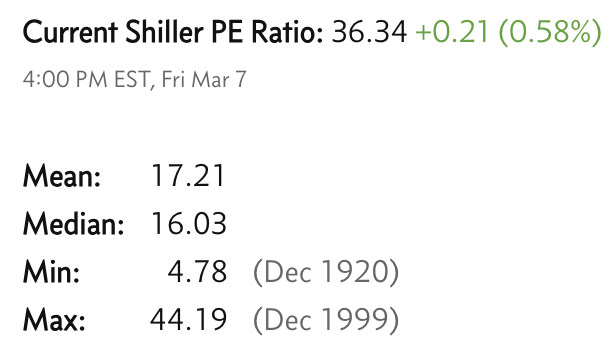Weekly Market Commentary - March 8th, 2025 - Click Here for Past Commentaries
-
U.S. economic growth has shown signs of shifting to a slower gear. Data thus far in the first
quarter points to softer consumption, with consumer sentiment surveys also indicating some
weariness in confidence overall.
A softening in growth in the first quarter of the year is not uncommon, but what is unique is
that the cooling in growth comes at a time of heightened policy uncertainty, around tariffs,
government funding, and cost-cutting initiatives.
The good news is that the U.S. economy has started from a position of strength and came into
the year with growth above trend. We don't yet see a recession on the horizon, and economic
momentum could reemerge later in the year if tax policy or deregulation come into the forefront.
Nonetheless, markets have taken a defensive posture in recent days. Defensive sectors, like
health care and consumer staples, are leading, while momentum and technology sectors are lagging.
Bond markets have provided support as well, with Treasury yields moving rapidly lower since
January (although we have seen stabilization in recent days), in part because additional Fed
rate cuts have now been priced in by markets.
-
After a strong end to 2024, with fourth-quarter GDP growth coming at 2.5% and consumption at a
healthy 4.2% pace, there is growing evidence that the U.S. economy may be slowing as we get
through the first quarter of 2025. Thus far, key economic indicators, including U.S. retail
sales and personal spending, have both surprised to the downside.
The Atlanta Fed GDP tracker is pointing to a -2.4% annualized growth rate for the first quarter,
after being as high as 3.9% earlier in the year. A large part of this move lower has been driven
by a sharp rise in imports, as companies look to build inventory ahead of potential tariffs. This
trend is likely not sustainable in the months ahead and should stabilize and reverse. However,
there was also a shift lower in consumption, which is now forecast to slow to about 0.4% in the
first quarter, after being as high as 4.1%. We know the consumption makes up about 70% of U.S.
GDP, and a slowing consumer weighs more heavily on economic growth over time.
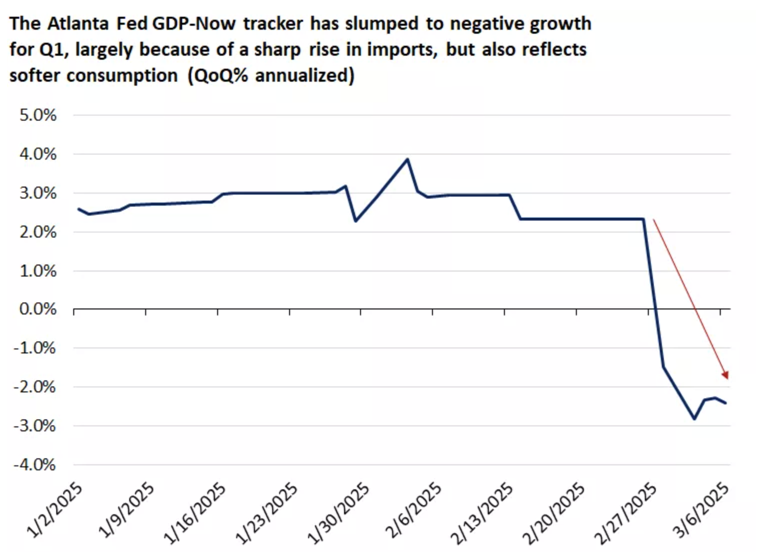
-
From a corporate earnings perspective, in the fourth quarter of 2024, S&P 500 earnings came in at about
18% year-over-year growth, its highest since 2021.1 However, as we look toward the first couple of
quarters of 2025, there has been a notable slowdown in earnings-growth forecasts. In fact, for the
first quarter, the earnings-growth expectation went from 11.5% at the start of the year to about 7.3%
currently. Similarly, for the second quarter, expectations went from 11.3% to 9.7%. So clearly
corporations and markets are lowering their outlooks for earnings in the first half of the year.
Forecasts for the back half the year remain steady – for now – which still leaves S&P 500 earnings
growth for the full year at about 11%.
Perhaps the other offset to the cooling in economic and earnings growth is that the Federal Reserve may be more willing to provide support and lower policy rates if these trends persist. Fed Chair Powell indicated last week that the economy remains in decent shape, and even though consumer spending is moderating, and uncertainty remains elevated, he expects the Fed to remain patient on rates. However, markets have gone from pricing in no rate cuts to about three rate cuts in 2025. In our view, assuming tariffs do not create an outsized move higher in inflation, the Fed is more likely on track to cut rates two or three times this year, particularly if the labor market shows signs of weakening.
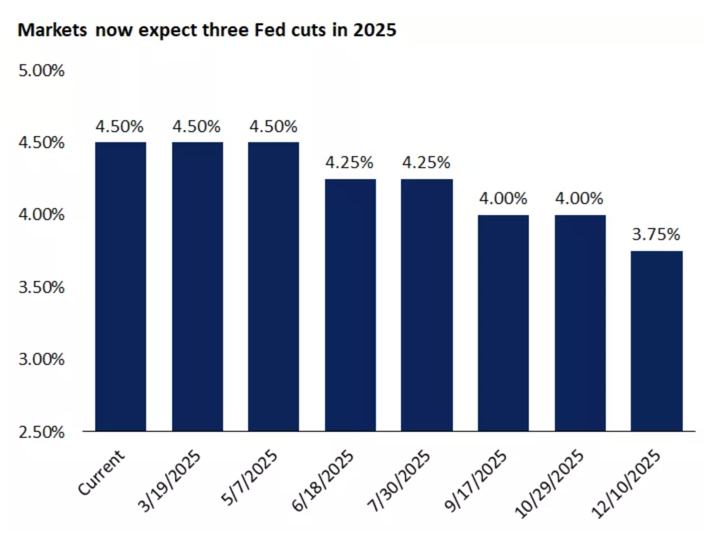
-
Overall, a slowing in the economy during the first quarter is not uncommon, but what is unique is the
rising uncertainty in areas like tariffs, government funding, and cost-cutting policy. These continue
to remain an overhang on markets and may be weighing on consumer spending and corporate activity.
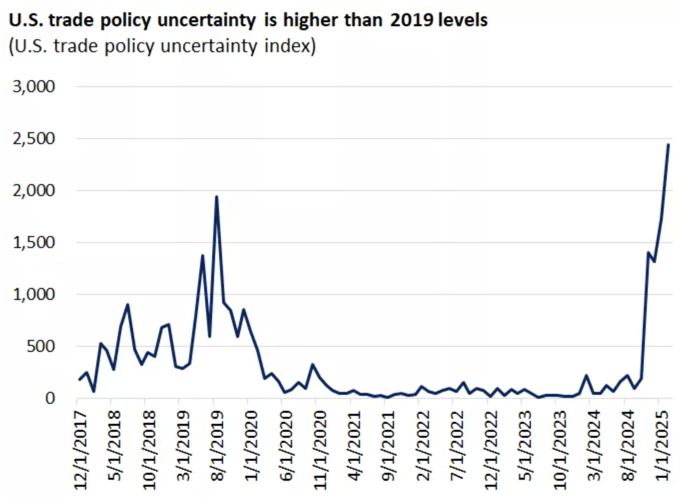
-
This past week, the administration again imposed 25% tariffs on Mexico and Canada, only to postpone them
for one month until April 2. Nonetheless, markets continued to fall, and sentiment did not seem bolstered
by this postponement, as the threat of tariffs now looms large for April, across not only Canada and Mexico,
but other economies like the European Union, which may be subject to reciprocal tariffs. Many economies,
including Canada and the European Union, have vowed to implement retaliatory tariffs if the U.S. raises
its tariff rates, which could lead to higher prices across goods and services for consumers and
corporations.
In addition to tariff uncertainty, government cost-cutting initiatives have pressured sentiment. While the U.S. jobs report for February was in line with expectations, with 151,000 jobs added and the unemployment rate ticking up only slightly to 4.1%, these figures do not yet reflect the federal government layoffs, which will likely dampen new job growth and increase unemployment. This comes at a time where new jobs added were already slowing, and corporations may be reconsidering hiring efforts in the face of tariffs and a potentially cooling economy.
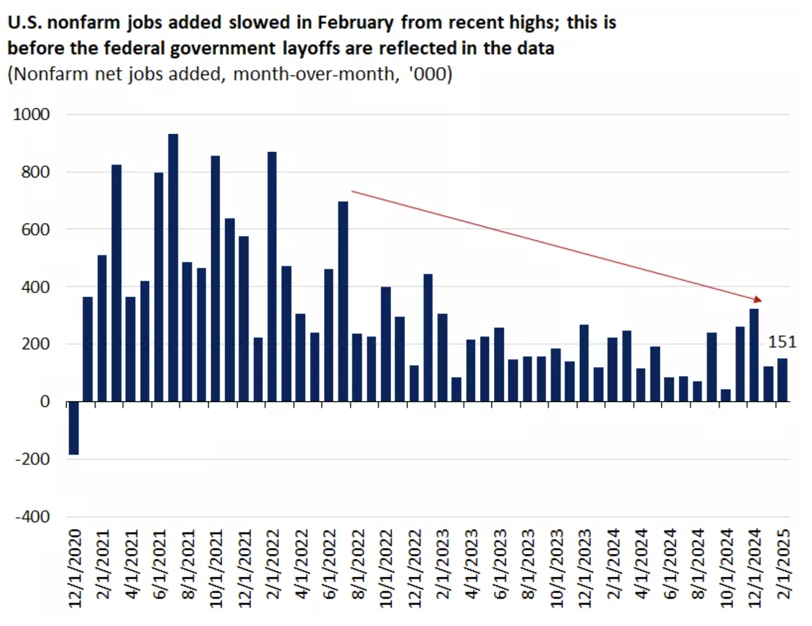
-
The uncertainty around tariffs and government policy broadly could cause both consumers and
corporations to hold off on spending and major investments, or delay capital markets activity
like acquisitions and IPOs. In recent weeks, we have also heard from big retailers like Target
and Walmart that have lowered their forecasts, driven by expectations of softer consumer
spending, and have also indicated that tariffs could spark higher prices in the months ahead.
As we look ahead on government policy initiatives, perhaps the good news is that while the administration is focused on tariffs and government layoffs now, it should start shifting its focus in the weeks ahead to more market-friendly policies, including tax cuts and deregulation. Although there may still be uncertainty on the outcomes of these policies, we believe markets will welcome a renewed focus on keeping corporate tax rates low and cutting regulation across sectors. Over time, we may also see the administration focusing less on tariff policies, perhaps after April, particularly if there are clear signs of more inflation and lower growth because of these actions.
Given the potential slowing economy and rising policy uncertainty, markets are understandably reacting with caution. The S&P 500 is now down about 2% for the year, while the technology-heavy Nasdaq is down about 6%.1 After two years of 20%+ returns in the S&P 500, though, some period of consolidation and pullback was probably warranted, and thus far markets are acting orderly.
Perhaps what is most notable are the rotations in the market happening underneath the surface. We are clearly seeing investors take more defensive posturing across asset classes. In stocks, we are seeing defensive, or "recession-proof," sectors showing leadership, including health care and consumer staples. The lagging sectors are those that have had the strongest momentum and rise in valuations, including technology (whose highest weights are in Apple, Microsoft, and NVIDIA) and consumer discretionary (whose highest weights are in Amazon and Tesla).
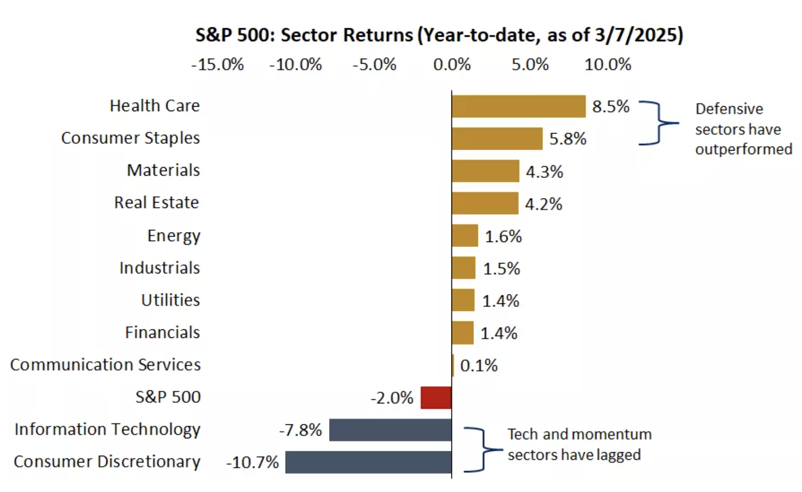
-
We are also seeing some investors move from U.S. equities to international equities, especially
European and Chinese technology stocks. This comes as the economic growth in the U.S. cools,
tariff and policy uncertainty rises, and investors seek better valuations and access to growth
and value stocks abroad.
Finally, in bonds, we have seen some flight to safety in U.S. Treasury bonds as stock market volatility rises. The 10-year Treasury yield, for example, was as high as nearly 4.8% in mid-January, but tumbled to about 4.15%, as concerns about economic growth and policy uncertainty came to the forefront. More recently, we have seen some stabilization, with 10-year yields back around 4.3%, but bonds could continue to play a stabilizing role in portfolios this year, especially as Fed rate cuts are also back on the table.
Overall, investors are understandably nervous – the economy seems to be softening as tariffs and government policy uncertainty remain elevated. But keep in mind that in any given year, one to three pullbacks are normal, in the 5% to 15% range, and historically these have led to buying opportunities. Especially because we don't yet see a recession, the likelihood of a deep or prolonged bear market is not as high.
Also remember that, historically, time in the market has been the better strategy than trying to time yourself in and out of the market. For long-term investors, this approach has led to meeting – and in some cases exceeding – financial goals. We recommend using periods of volatility to consider rebalancing your portfolios or diversifying across stocks and bonds, or simply starting a list of potential investments to buy if we do get better prices ahead. If needed, reach out to a financial advisor who can help you ensure that your investments are aligned with your personal long-term financial goals and can help you navigate portfolios through bouts of market volatility.
-
Final Words: Markets are at the all time high and fed is cutting
interest rate, caution warranted. Below is CNN Greed vs Fear Index, pointing at
'Extreme Fear'.
Below is last week sector performance report.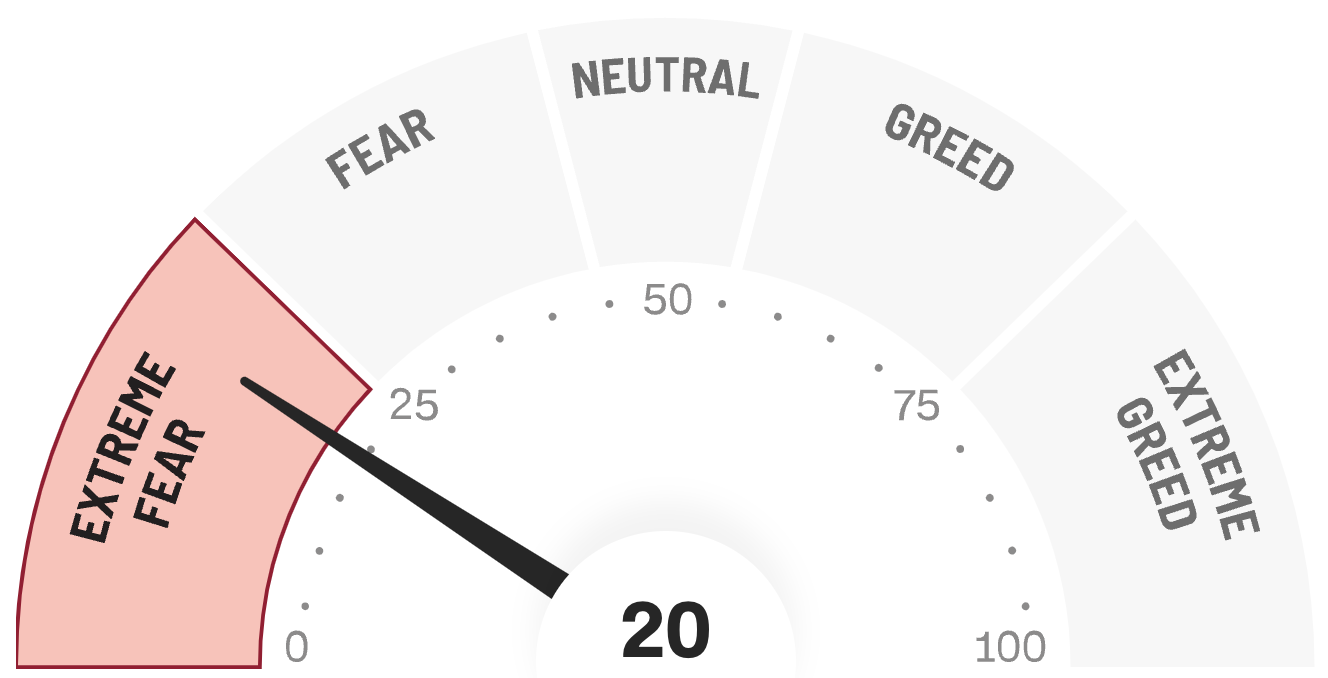
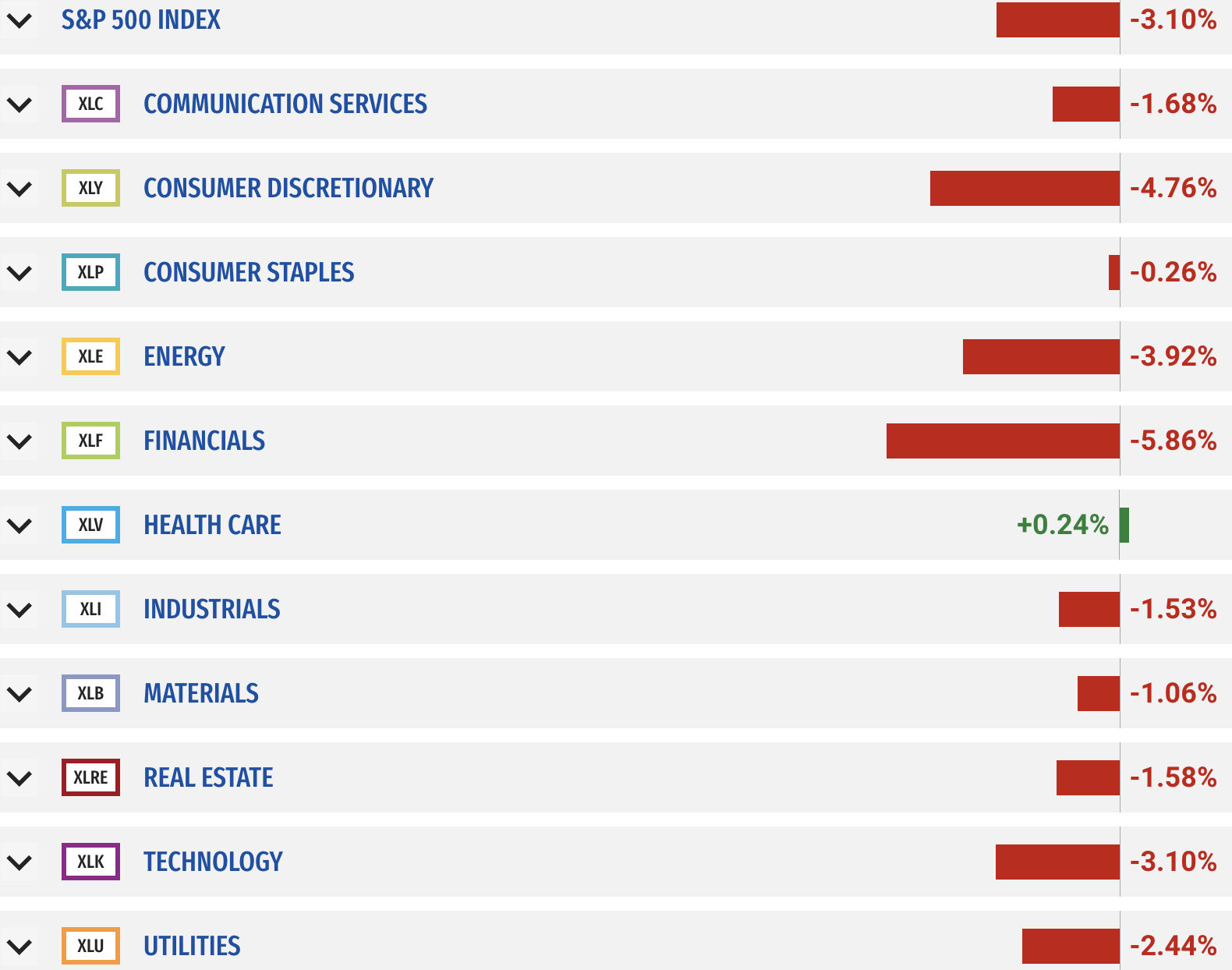
If you are looking for investment opportunities, you can take a look at our
Hidden Gems
section, and if you want to see our past performance, visit our
Past Performance section. If you are looking for
safe and low cost Exchange Traded funds(ETFs), check out our
ETF recommendations.
Currrent Shiller PE (see below) is showing overbought conditions as index is far above mean/media
and our AryaFin engine is indicating caution. Have a good weekend.
